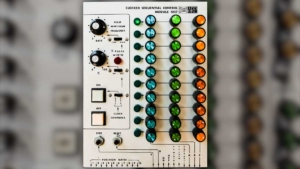The ARP Module 1027 Clocked Sequential Control
by Chris Meyer of LearningModular.com
One of the main attractions to using a synthesizer is its ability to create sounds ranging from the familiar to those that cannot be created by traditional instruments. Similarly, some synthesizer modules allow the composer or performer to create strings of notes that would be impossible to play by hand.
The most common tool for this is a module known as a sequencer. For those unfamiliar with them, a sequencer has a number of steps, each of which can be adjusted to output the parameters or voltages required to define an individual note. These parameters usually include the pitch but could also include voltages to control the loudness, articulation, or timbre of the note. The composer or performer sets the values of these parameters ahead of time. They would then use either an external trigger signal or a built-in clock to step through the resulting sequence of notes.
The ARP Module 1027 Clocked Sequential Control featured 10 “Positions” or steps, with controls to set three different voltage output parameters per Position. It too could be stepped through its Positions using an external trigger from another module, or by using its internal voltage-controlled clock with a “Pulse Repetition Frequency” that could go from 20 steps per minute (20 BPM) to 400 per second – well into the audio range!
In addition to outputting the three voltages associated with each Position, the 1027 could also send a “Clock Out” signal that was used as a gate signal to signify each new note event. The “Pulse Width” of this gate is set either by a front panel control or a separate voltage control input. When this gate signal is patched to an envelope generator, the Pulse Width determines how long the envelope is held at its sustain phase and is set as a percentage of the note’s overall duration – from 0% to 100% from the front panel, and according to its brochure from 5% to 95% under voltage control (in other words, from staccato to tenuto). This feature was unique to the 1027 at the time.
Since the voltage parameter rows of the Module 1027 could be patched back to these voltage-controlled clock rate and pulse width parameters, a composer had considerable control over the duration and articulation of each individual note in the sequence.
The 1027 could also output a separate “Position Gate” for each individual step, one of which was patched back into the 1027’s Reset input to set the length of the sequence. Other ARP 2500 modules – such as the Module 1036 Sample & Hold Random Voltage – could be patched to the 1027’s Reset input (as well the 1050’s Step input), in this case to create random sequences.
The 1027 could also be used in conjunction with the ARP Module 1050 Mix Sequencer to select one parameter row at a time to send to other modules, resulting in sequences up to 30 steps long.
It’s amazing to think the Module 1027 could do all of this with essentially transistor-based technology. Sequencers in today’s modular synthesizers can range from basic units that are simpler in function than the 1027, to microprocessor-controlled composition stations that include and go beyond the capabilities outlined above. However, when most electronic music listeners think of “sequenced” music, they’re usually thinking of the repetitive strings of notes that the Module 1027 in its simplest application made possible with the ARP 2500.




